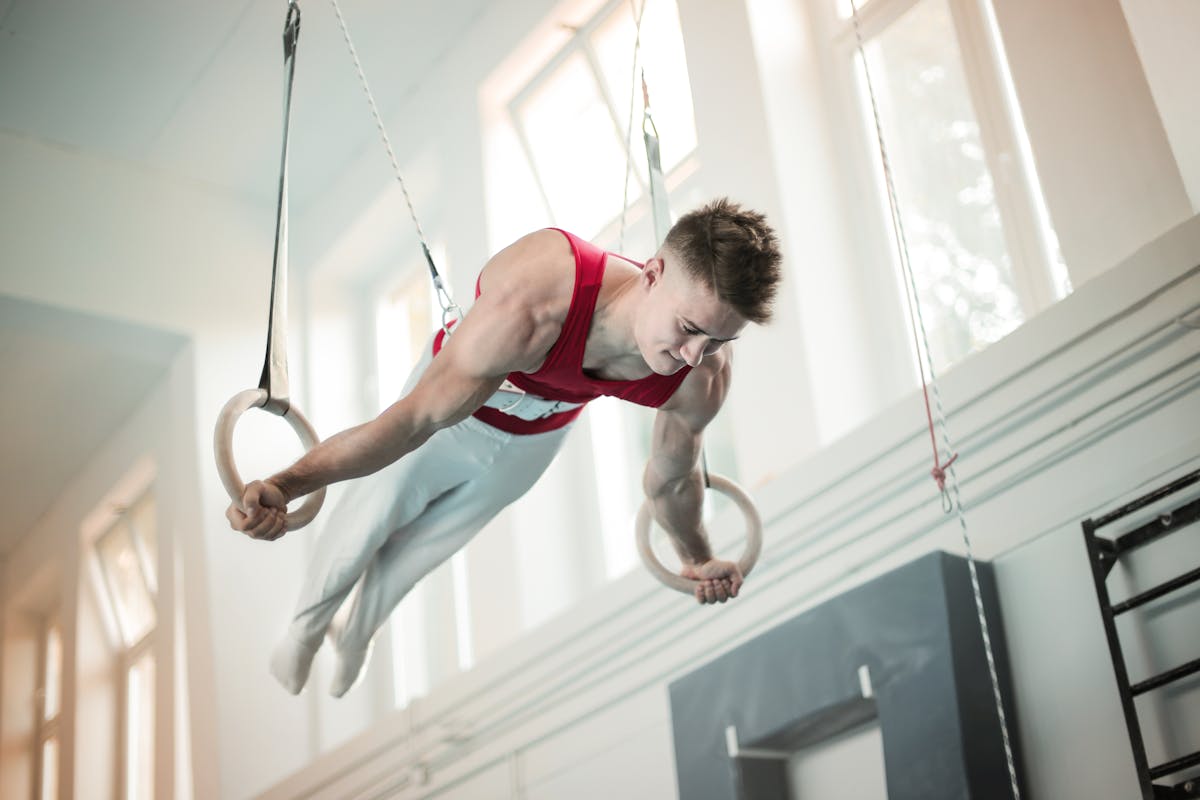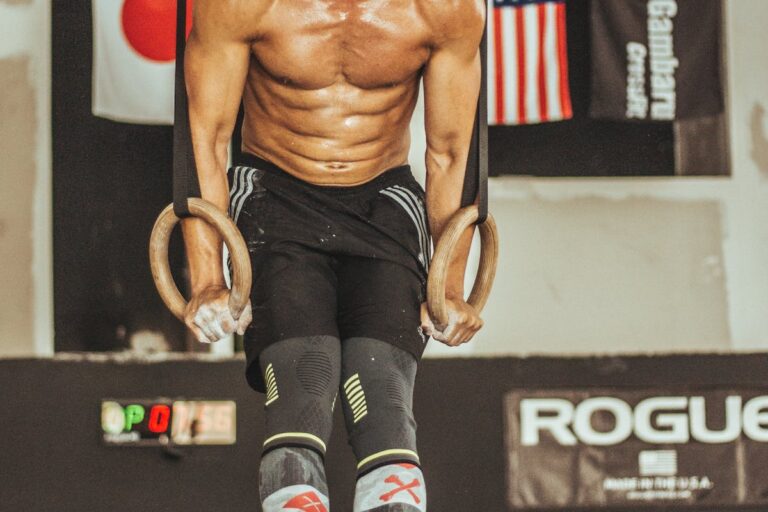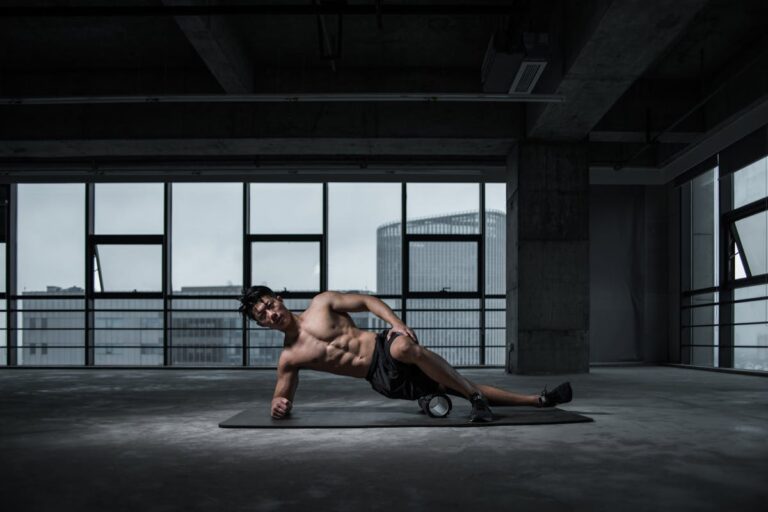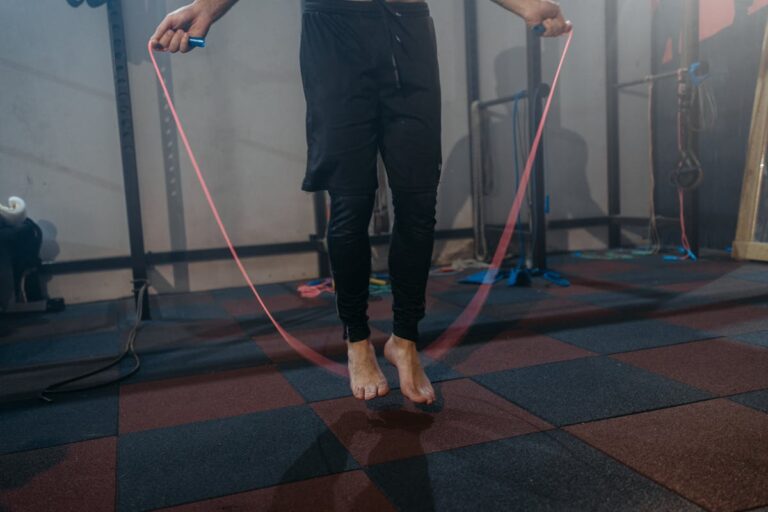Top 5 Calisthenics Workout Routines for Beginners
Calisthenics Workout Routines for Beginners
Discover the top 5 calisthenics workout routines for beginners to build strength, flexibility, and endurance. Start your fitness journey with these easy-to-follow exercises today!
Table of Contents
Introduction to Calisthenics
Calisthenics is a form of exercise that utilizes an individual’s body weight to improve strength, flexibility, endurance, and coordination. This style of workout emphasizes functional movements, which enhance everyday activities by promoting full-body engagement. Ideal for beginners, calisthenics does not require any specialized equipment, making it accessible to anyone, anywhere.
Key characteristics of calisthenics include:Calisthenics Workout Routines for Beginners
- Bodyweight Exercises: In calisthenics, the primary resistance comes from the individual’s body weight. Common exercises involve pushing, pulling, bending, jumping, or swinging, which naturally employ various muscle groups.
- Versatility: Exercises can be performed anywhere—whether at home, in a park, or in a gym. This versatility removes barriers related to gym memberships or space constraints.
- Progressive Training: Calisthenics routines allow for progressive overload by increasing the difficulty level of movements. Beginners might start with simple actions, like push-ups or squats, and gradually advance to more complex variations, such as handstand push-ups or pistol squats.
- Functional Movement Patterns: These exercises mirror movements used in daily life, enhancing muscular coordination and improving general athleticism.
- Minimal Equipment: While advanced calisthenics practitioners may incorporate pull-up bars, parallel bars, or resistance bands, most exercises require nothing more than a clear space and the individual’s body.
Types of basic exercises in calisthenics:
- Push-Ups: Targets the chest, shoulders, and triceps while engaging the core and lower back muscles for stabilization.
- Pull-Ups: Strengthens the upper back, shoulders, and arms.
- Squats: Develops the quadriceps, hamstrings, glutes, and calves.
- Dips: Enhances triceps, chest, and shoulder strength.
- Leg Raises: Focuses on the core muscles, particularly the abdominals and hip flexors.
Benefits of calisthenics include:
- Improved Muscular Endurance: Regular practice can significantly boost muscular stamina, making everyday tasks easier.
- Enhanced Joint Mobility: Many calisthenics movements involve a full range of motion, promoting joint health and flexibility.
- Increased Body Awareness: As a haven for bodyweight exercises, calisthenics fosters better control over movement and posture.
- Accessibility: With no need for gym equipment, anyone can begin practicing calisthenics, regardless of fitness level.
Benefits of Calisthenics for Beginners
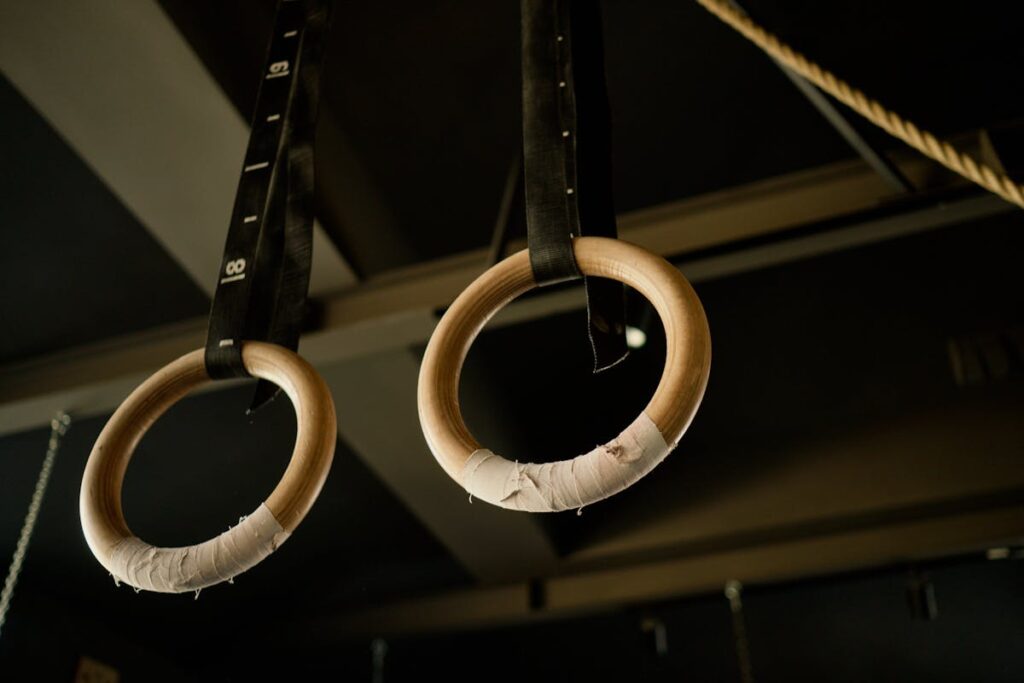
Diving into calisthenics offers numerous advantages for beginners. Here are several key benefits:
1. Improved Functional Strength
Calisthenics focuses on compound movements that mimic real-life activities. This can improve overall functional strength, making everyday tasks easier.
2. Increased Flexibility
Regular calisthenics routines include a variety of stretches and dynamic movements that enhance flexibility. This helps in preventing injuries and improving range of motion.
3. Enhanced Cardiovascular Health
Exercises such as jumping jacks, burpees, and high knees are cardiovascular-intensive, promoting heart health and improving endurance.
4. No Equipment Needed
One of the most significant advantages is that calisthenics requires no special equipment. Exercises rely on body weight, making it accessible to everyone, regardless of their financial situation.
5. Can Be Done Anywhere
Since no equipment is needed, calisthenics can be performed in various settings such as at home, in parks, or even in hotel rooms while traveling.
6. Gradual Progression
Beginners can start with basic exercises like squats and push-ups and progressively move to more challenging variations like pistol squats and one-arm push-ups. This gradual increase in difficulty helps motivate and prevent burnout.
7. Improved Body Composition
Calisthenics helps in burning fat and building muscle simultaneously, leading to better body composition. Consistent training can result in a more toned and defined physique.
8. Increased Coordination and Balance
Exercises often incorporate multiple muscles and joints, enhancing overall coordination and balance over time. This can be particularly beneficial for older adults or those recovering from injuries.
9. Low Risk of Injury
When performed with proper form, calisthenics exercises have a lower risk of injury compared to weight lifting. This makes it a great start for beginners who are new to exercise.
10. Mental Health Benefits
Exercise has been proven to release endorphins, which can improve mood and reduce stress. Regular calisthenics routines can lead to better mental health outcomes.
11. Community Support
Many communities and online groups are dedicated to calisthenics, offering support, motivation, and advice. This can be particularly encouraging for those just starting their fitness journey.
12. Holistic Fitness Approach
Calisthenics offers a comprehensive workout focusing on strength, flexibility, endurance, and balance, promoting overall physical well-being.
Incorporating calisthenics into a beginner’s fitness regime provides a solid foundation for improved health, without the need for extensive equipment or facilities.
Warm-Up Exercises to Begin With
Before diving into calisthenics workouts, it is crucial to start with warm-up exercises that prepare the body for physical activity and reduce the risk of injury. Warm-up routines should increase heart rate, loosen up muscles, and improve joint mobility. Here are some effective warm-up exercises to consider:
Dynamic Stretching
Dynamic stretches involve moving parts of the body and gradually increasing reach, speed of movement, or both. They are ideal for warming up as they mimic the movements of the workout ahead.
- Arm Circles: Stand with feet shoulder-width apart and extend arms out to the sides. Make small circles for 30 seconds, then reverse the direction.
- Leg Swings: Hold onto a sturdy object for balance. Swing one leg forward and backward, keeping it straight. Repeat for 15 reps on each leg.
- Hip Rotations: Place hands on hips and make wide circles with the hips. Rotate clockwise for 15 seconds and then counterclockwise for another 15 seconds.
Cardio Warm-Up
Engaging in light cardiovascular activity helps elevate the heart rate and circulation, preparing the body for more intense exercise.
- Jumping Jacks: Perform 20-30 jumping jacks, ensuring a full range of motion with arms and legs.
- High Knees: Run in place, bringing knees up toward the chest. Continue for 30 seconds to one minute.
- Butt Kicks: Jog in place while trying to kick the heels up toward the glutes. Perform this exercise for 30 seconds.
Joint Mobilization
Mobilizing the joints enhances flexibility and prepares them for the range of motion needed in calisthenics exercises.
- Ankle Circles: Lift one foot off the ground and rotate the ankle clockwise for 10 seconds, then counterclockwise for another 10 seconds. Switch to the other ankle and repeat.
- Shoulder Rolls: Stand tall and roll shoulders forward in a circular motion for 15 seconds, then reverse for another 15 seconds.
- Wrist Flexor Stretch: Extend one arm in front with the palm facing up. Use the other hand to gently pull back on the fingers, stretching the wrist flexors. Hold for 15 seconds and switch to the other side.
Following these warm-up exercises helps ensure the body is adequately prepared for a calisthenics workout. Starting with a proper warm-up improves performance and minimizes the risk of injury, setting a solid foundation for a successful workout routine.
Routine 1: Basic Push-Up Session
The basic push-up is a foundational calisthenics exercise that targets the chest, shoulders, triceps, and core muscles. It requires no equipment and can be performed almost anywhere, making it perfect for beginners.
Step-by-Step Instructions
- Starting Position:
- Begin in a high plank position with hands placed slightly wider than shoulder-width apart.
- Keep feet together and body in a straight line from head to heels.
- Engage the core muscles to maintain proper alignment.
- Lowering Phase:
- Inhale as you slowly bend the elbows and lower the body toward the floor.
- Maintain a straight back and avoid sagging the hips.
- Lower until the chest is just above the ground or as far as the body allows without compromising form.
- Pushing Up:
- Exhale while pressing forcefully through the palms to straighten the arms and lift the body back to the starting position.
- Ensure elbows are not locked and maintain a slight bend for joint health.
- Repetition and Sets:
- Aim for 3 sets of 8-12 repetitions as a starting point.
- Rest for 60-90 seconds between sets.
Tips for Proper Form
- Hand Placement: Proper hand placement helps ensure correct muscle engagement. Hands should be slightly wider than shoulder-width apart.
- Core Engagement: Keeping the core tight prevents lower back sagging.
- Breathing Technique: Inhale during the lowering phase and exhale while pushing up.
- Elbow Position: Avoid flaring elbows out excessively; keep them at a 45-degree angle to the body.
- Neck Alignment: Keep the head in a neutral position, looking slightly ahead rather than at the floor.
Common Mistakes to Avoid
- Sagging Hips: Ensure the body maintains a straight line throughout the movement.
- Incomplete Range of Motion: Lower the body until the chest is near the floor for full muscle engagement.
- Rapid Repetitions: Perform each repetition in a controlled manner for maximum benefit.
Progress Variations
- Knee Push-Ups: Perform the exercise on the knees instead of the toes to reduce intensity.
- Incline Push-Ups: Use a bench or elevated surface to make the exercise easier.
- Decline Push-Ups: Place feet on an elevated surface to increase difficulty.
By mastering the basic push-up, beginners can build a solid foundation for more advanced calisthenics exercises.
Routine 2: Squat and Lower Body Workout
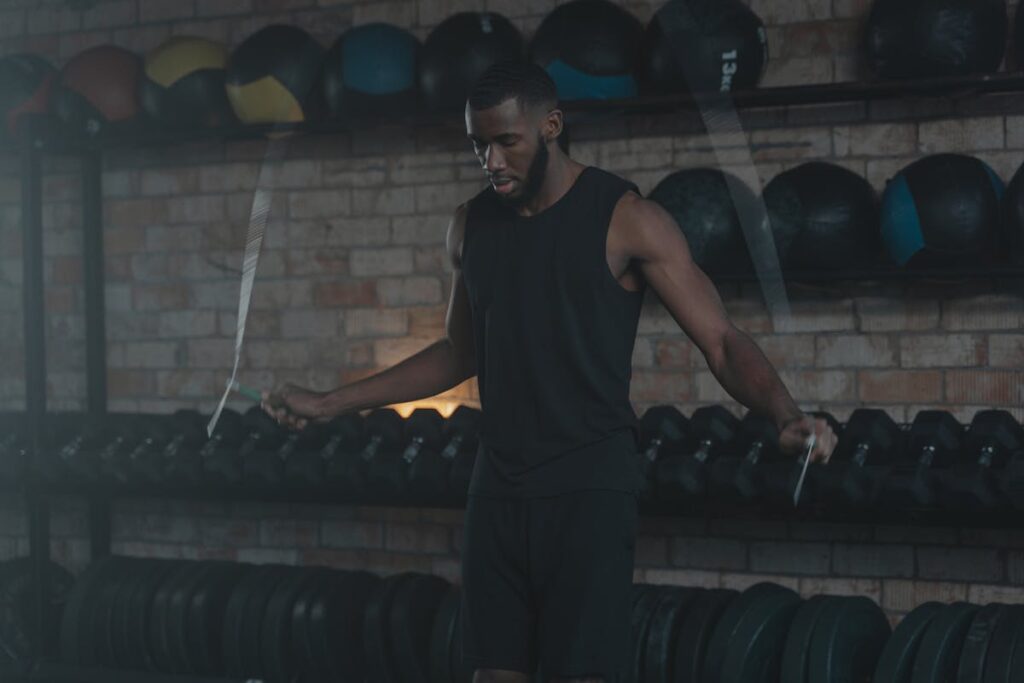
A well-rounded calisthenics workout must include exercises that target the lower body, crucial for building strength and improving balance. This routine focuses on squats and other lower body moves to help beginners develop foundational muscles and movements.
Warm-Up
Begin with a 5-10 minute warm-up to increase heart rate and loosen muscles. Consider activities such as:
- Jumping jacks
- High knees
- Butt kicks
- Lateral leg swings
Main Exercises
- Bodyweight Squats
- Repetitions: 3 sets of 10-15 reps
- Form: Stand with feet shoulder-width apart, keep chest up, and lower body until thighs are parallel to the ground.
- Lunges
- Repetitions: 3 sets of 10 reps per leg
- Form: Step forward with one leg, lower hips until back knee nearly touches the ground, and keep front knee stacked over ankle.
- Glute Bridges
- Repetitions: 3 sets of 15-20 reps
- Form: Lie on back with knees bent and feet flat, lift hips towards ceiling while squeezing glutes.
- Calf Raises
- Repetitions: 3 sets of 15-20 reps
- Form: Stand with feet shoulder-width apart, rise onto toes, hold for a second, and lower down slowly.
- Wall Sit
- Duration: 3 sets of 30 seconds to 1 minute
- Form: Lean against a wall with feet shoulder-width apart, slide down until knees are at a 90-degree angle.
Cool-Down
Finish with a cool-down to help relax the muscles and improve flexibility. Effective cool-down activities may include:
- Hamstring stretches
- Quadriceps stretches
- Calf stretches
- Hip flexor stretches
Tips for Success
- Maintain proper form to maximize benefits and prevent injuries.
- Progress gradually by increasing repetitions or holding positions longer.
- Stay hydrated and listen to the body’s signals.
By incorporating this squat and lower body workout routine, beginners can build a solid foundation in calisthenics and enhance overall lower body strength and stability.
Routine 3: Building Core Strength with Planks
Planks are an excellent exercise for developing core strength, stability, and endurance. They engage multiple muscle groups simultaneously, including the abdominals, back, shoulders, and glutes. Beginners can benefit greatly from incorporating plank variations into their calisthenics routine.
Standard Plank
- Start Position: Begin in a push-up position with your arms straight and hands placed directly under your shoulders. Ensure your body forms a straight line from head to heels.
- Engage Core: Tighten your core muscles, glutes, and thighs to maintain a rigid posture.
- Hold Position: Aim to hold the plank for 20-30 seconds. Gradually increase the duration as your strength improves.
Forearm Plank
- Start Position: Lie face down and elevate yourself onto your forearms and toes. Ensure your elbows are aligned under your shoulders.
- Body Alignment: Keep your body in a straight line from head to heels, avoiding any sagging or arching of the back.
- Hold Position: Maintain the position for 20-30 seconds. Increase the time as your endurance builds.
Side Plank
- Start Position: Lie on your side and prop yourself up on your forearm, with your elbow directly below your shoulder. Your other hand can rest on your hip or be raised toward the ceiling.
- Align Body: Raise your hips so that your body forms a straight line from head to feet.
- Hold Position: Try holding for 15-20 seconds on each side. Gradually extend the duration over time.
Plank with Leg Lift
- Standard Plank Position: Begin in the standard plank position with your body in a straight line.
- Leg Lift: Lift one leg towards the ceiling without bending it. Engage your glutes and keep your body stable.
- Alternate Legs: Hold for 3-5 seconds before switching to the other leg. Repeat 8-10 times for each leg.
Plank with Shoulder Tap
- Standard Plank Position: Start in the standard plank position, ensuring a straight line from head to heels.
- Shoulder Tap: Lift one hand to tap the opposite shoulder. Maintain stability without rocking your hips.
- Alternate Sides: Alternate tapping each shoulder for 10-12 repetitions per side.
> Consistency and gradual progression are key to building core strength with planks. Incorporating these variations will help create a balanced and effective calisthenics routine for beginners.
Routine 4: Pull-Up Techniques and Progressions
Pull-ups are quintessential in any calisthenics routine as they effectively build upper body strength. Beginners can utilize several techniques and progressions to successfully perform pull-ups.
Starting with Assisted Pull-Ups
- Resistance Bands:
Using resistance bands provides support by reducing the body weight lifted. Loop a band over a pull-up bar and place a foot or knee in the band to assist in lifting. - Assisted Machines:
Many gyms offer pull-up assist machines. These machines counterbalance body weight, making the exercise easier to perform. - Partner Support:
Having a workout partner hold the legs or hips can help generate the necessary lift to complete the pull-up motion.
Building Strength Gradually
- Negative Pull-Ups:
Focus on the descent phase. Begin by using a step or jump to get the chin above the bar, then slowly lower the body down. This eccentric motion builds the necessary muscles. - Australian Pull-Ups (Body Rows):
Perform these using a low bar. Lie beneath the bar and pull the chest towards it, utilizing a more horizontal position to reduce the intensity. - Scapular Pull-Ups:
Hang from the pull-up bar and perform small movements by retracting shoulder blades downward without bending the elbows. This strengthens the upper back muscles.
Progressing Towards Unassisted Pull-Ups
- Full Range of Motion:
Practice partial range pull-ups, progressing from ¼, ½, and ¾ ranges until full pull-ups are achievable. - Increase Frequency and Volume:
Integrate pull-up variations into routines multiple times a week. Aim for a mixture of higher rep sets with assistance and lower reps without. - Improving Grip Strength:
Stronger grip can significantly aid pull-up performance. Incorporate farmer’s walks, dead hangs, and grip strengthening tools like hand grippers.
Monitoring and Adjusting Progress
- Consistent Tracking:
Keep track of the number of reps, sets, and any assistance used. Recording progress helps in identifying improvement areas. - Regular Assessments:
Routinely attempt unassisted pull-ups to measure progress, adjusting the intensity and volume of sessions accordingly. - Flexibility and Mobility:
Incorporate stretching and mobility exercises for shoulders and back to prevent strain and enhance pull-up performance.
Ensuring consistency and adherence to these techniques will progressively build the strength necessary for performing unassisted pull-ups, augmenting an individual’s overall calisthenic strength.
Routine 5: Full-Body Circuit Workout
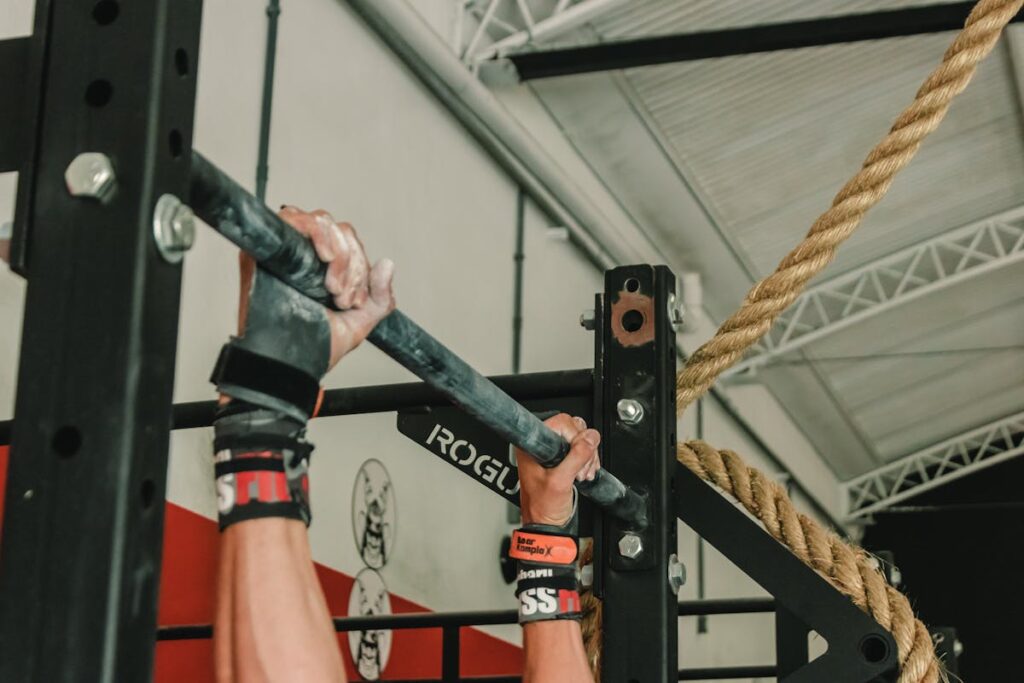
The Full-Body Circuit Workout is designed to target all major muscle groups in a quick and efficient manner. This routine combines strength, endurance, and cardiovascular elements to provide a well-rounded workout experience. Beginners can perform this circuit at their own pace and gradually increase intensity as they build strength and stamina.
Warm-Up
Begin with a 5-10 minute warm-up to prepare the body for the workout. This could include:
- Jumping jacks
- Arm circles
- High knees
- Dynamic stretches
Circuit Exercises
Perform the following exercises in a circuit format. Complete each exercise for 30 seconds, followed by 15 seconds of rest. After one round, rest for 1-2 minutes and then repeat the circuit 2-3 more times.
- Push-Ups
- Targets chest, shoulders, and triceps
- Keep the body in a straight line from head to heels
- Bodyweight Squats
- Targets quads, hamstrings, and glutes
- Ensure knees do not extend past toes
- Plank
- Engages the core, shoulders, and back
- Maintain a straight line from head to heels
- Lunges
- Strengthens quads, hamstrings, and glutes
- Step forward and lower the body until both knees are bent at 90 degrees
- Dips (using a chair or bench)
- Focuses on triceps, shoulders, and chest
- Lower the body until the elbows form a 90-degree angle
- Mountain Climbers
- Enhances cardiovascular endurance while targeting the core and legs
- Ensure quick knee drives toward the chest
- Superman
- Strengthens the lower back and glutes
- Lift arms, chest, and legs off the ground while lying face down
Cool-Down
End the workout with a 5-10 minute cool-down. Focus on:
- Static stretching (hamstrings, quads, calves, shoulders)
- Deep breathing exercises
- Relaxation techniques to lower the heart rate
Tips for Success
- Maintain proper form to prevent injuries
- Listen to the body and rest when needed
- Stay hydrated before, during, and after the workout
- Incorporate this routine 2-3 times a week for best results
A full-body circuit workout not only builds muscle but also improves cardiovascular health and overall fitness.
Cool Down and Stretching Tips
Engaging in calisthenics is an excellent way to build strength and flexibility, but it is equally important to properly cool down after a workout to prevent injury and aid in recovery. The following tips provide a structured approach to cooling down and stretching after a calisthenics session:
- Gradual Decrease in Intensity:
- Reduce the intensity of exercises slowly rather than stopping abruptly. For instance, if the routine ends with high-intensity movements, transition to lower-intensity activities like walking or gentle jogging for about 5-10 minutes.
- Incorporate slow, deep breathing to help the body decrease heart rate and relax muscles.
- Static Stretching:
- Perform static stretches, holding each for at least 20-30 seconds. Focus on the major muscle groups used during the workout. Key areas to target include:
- Shoulders: Cross one arm across the body using the opposite hand to deepen the stretch.
- Chest: Clasp hands behind the back and gently lift to open up the chest muscles.
- Hamstrings: Sit with legs extended, reaching for the toes while keeping the back straight.
- Quadriceps: Stand on one leg, pulling the opposite foot towards the glutes to stretch the front thigh.
- Calves: Place one foot forward in a lunge position, pressing the heel of the back foot into the ground.
- Perform static stretches, holding each for at least 20-30 seconds. Focus on the major muscle groups used during the workout. Key areas to target include:
- Flexibility Exercises:
- Incorporate flexibility exercises like yoga poses which are excellent for cooling down. Examples include:
- Downward Dog: Stretches the hamstrings, calves, and shoulders.
- Cat-Cow Stretch: Offers flexibility and relief to the spine.
- Child’s Pose: Allows the muscles to relax and stretch, promoting a sense of calm.
- Incorporate flexibility exercises like yoga poses which are excellent for cooling down. Examples include:
- Use of Props:
- Utilize props like a foam roller to self-massage tight muscles. This can help in reducing post-workout stiffness:
- Roll gently over areas like the back, thighs, and calves to release tension.
- Incorporate a stretching strap for deeper stretches, allowing for better reach and support.
- Utilize props like a foam roller to self-massage tight muscles. This can help in reducing post-workout stiffness:
- Hydration and Nutrition:
- Rehydrate by drinking water or electrolyte-replenishing drinks. It aids in muscle recovery and reduces the chances of cramping.
- Consuming a light snack with proteins and carbohydrates post-exercise can replenish energy levels and support muscle repair.
By integrating these cool-down and stretching tips, beginners can aid recovery, enhance flexibility, and reduce the risk of injury, ensuring a healthier and more effective calisthenics journey.
Nutritional Advice for Beginners
Proper nutrition is crucial for beginners starting calisthenics workout routines. It provides the necessary energy and nutrients to fuel workouts and aid recovery. Here are some key dietary tips for beginners:
- Balanced Diet: Ensure a balanced intake of macronutrients – proteins, carbohydrates, and fats.
- Proteins: Essential for muscle repair and growth. Consider lean sources like chicken, fish, eggs, legumes, and tofu.
- Carbohydrates: Primary energy source. Opt for complex carbs such as whole grains, vegetables, and fruits.
- Fats: Necessary for hormone production and overall health. Include healthy fats like avocados, nuts, seeds, and olive oil.
- Hydration: Staying well-hydrated is vital for optimal performance and recovery. Aim for at least 8-10 glasses of water daily. Increased intake may be necessary during intense workouts.
- Pre-Workout Nutrition: Eating a small meal or snack an hour before exercising can provide energy and improve performance. Focus on:
- Carbohydrates for immediate energy.
- A small amount of protein for muscle support.
- Post-Workout Nutrition: Post-workout meals aid in recovery and muscle building. Ideally, consume something within 30-60 minutes after exercising. Include:
- Protein to repair muscles.
- Carbohydrates to replenish energy stores.
- Micronutrients: Vitamins and minerals are crucial for various bodily functions, including muscle contraction and hydration.
- Iron: Vital for oxygen transport. Sources include red meat, spinach, and broccoli.
- Calcium & Vitamin D: Important for bone health. Found in dairy products, fortified foods, and fatty fish.
- Magnesium: Supports muscle function and recovery. Found in nuts, seeds, and green leafy vegetables.
- Consistent Eating Schedule: Maintain a consistent eating schedule to regulate metabolism and maintain energy levels throughout the day.
- Avoid Processed Foods: Minimize consumption of processed and junk foods. These often contain unhealthy trans fats, excessive sugars, and sodium which can hinder performance and overall health.
- Listen to Your Body: Pay attention to hunger and fullness cues. Ensure not to under-eat or over-eat, adapting intake based on activity levels and exercise intensity.
Implementing these nutritional strategies can significantly enhance the benefits of calisthenics workouts, promoting healthier lifestyle habits and more effective training outcomes.
Common Mistakes to Avoid
When starting with calisthenics, beginners often make several common mistakes that can hinder progress or lead to injuries. Being aware of these mistakes can help in maintaining an effective and safe workout routine.
Skipping Warm-ups and Cool-downs
Neglecting to warm up before a workout and cool down afterward is a significant oversight. Warm-ups increase blood flow to muscles and prepare the body for exercise, reducing the risk of injury. Cool-downs help to gradually reduce heart rate and prevent muscle stiffness.
Poor Form and Technique
Maintaining proper form is crucial in calisthenics to maximize benefits and minimize injury risks. Beginners sometimes rush through exercises without focusing on technique, which can lead to poor performance and increased injury risk.
Overtraining
Overtraining happens when beginners push their bodies too hard without sufficient rest. This can result in fatigue, burnout, and even injuries. It is essential to listen to the body and incorporate rest days into the workout routine.
Ignoring Progression
Progression is key in calisthenics. Starting with exercises that are too advanced can lead to discouragement or injury. Beginners should start with basic movements and gradually increase the difficulty as strength and skill improve.
Unbalanced Workout Routines
Some beginners might focus too much on certain exercises like push-ups, neglecting other areas such as pull-ups or leg exercises. This can lead to muscle imbalances and ineffective overall fitness. A balanced workout routine targeting different muscle groups is necessary.
Improper Breathing Techniques
Breathing plays a vital role in exercise performance and endurance. Beginners often hold their breath during exercises, which can lead to dizziness and reduced efficiency. Learning proper breathing techniques is essential for effective workouts.
Lack of Consistency
Inconsistency can significantly hamper progress. Skipping workouts or not following a regular schedule can lead to slow improvement and loss of motivation. Consistent workout routines are key to seeing results.
Unrealistic Expectations
Expecting instant results can be discouraging. Building strength and mastering calisthenics exercises takes time and dedication. It is important for beginners to set realistic goals and be patient with their progress.
Inadequate Nutrition and Hydration
Nutrition and hydration are often overlooked aspects of a fitness routine. Proper diet and adequate water intake are crucial for supporting workouts and recovery. Beginners should focus on balanced nutrition and staying hydrated.
Neglecting Rest and Recovery
Rest and recovery are critical components of an effective fitness routine. Not allowing the body to rest can impede muscle recovery and growth, leading to decreased performance and potential injuries. Incorporating sufficient rest is vital for sustained progress.
Tracking Progress and Setting Goals
Monitoring progress and setting achievable goals are crucial components for anyone embarking on a calisthenics journey. A structured approach ensures continuous improvement and keeps the individual motivated. Here are effective methods and strategies:
Keeping a Workout Journal
Maintaining a workout journal helps to:
- Log Exercises: Document the specific exercises performed each session.
- Track Repetitions and Sets: Record the number of repetitions and sets completed to identify improvements or plateaus.
- Note Feelings: Write down how one feels during and after workouts to understand energy levels and recovery.
Setting SMART Goals
SMART goals are essential for effective progress. Each goal should be:
- Specific: Clearly define what is to be achieved.
- Measurable: Include criteria that allow tracking progress.
- Achievable: Set realistic objectives considering the current fitness level.
- Relevant: Ensure the goal aligns with overall fitness plans.
- Time-bound: Set a timeframe to achieve each goal.
Regular Assessments
Evaluate progress through regular assessments:
- Monthly Check-ins: Schedule monthly reviews to adjust goals and note improvements.
- Fitness Tests: Perform fitness tests like maximum pull-ups or push-ups to gauge strength increases.
- Body Measurements: Measure body metrics such as weight, muscle mass, and body fat percentage.
Utilizing Technology
Leverage technology to enhance tracking:
- Fitness Apps: Use apps specifically designed for calisthenics to log workouts and monitor performance.
- Wearable Devices: Employ fitness trackers to measure heart rate, calories burned, and sleep patterns.
Celebrating Milestones
Acknowledging achievements boosts morale:
- Personal Rewards: Treat oneself for reaching significant milestones.
- Visualization: Keep a visual tracking board to showcase progress.
By diligently tracking progress and setting realistic goals, individuals can maintain motivation and achieve sustainable improvement in their calisthenics routines. Such a structured approach also helps in refining techniques and pushing past plateaus to reach new levels of physical fitness.
Motivation and Mental Preparation
Starting a new workout routine can be challenging, especially for beginners in calisthenics. Having the right motivation and mental preparation is crucial.
Setting Goals
Establishing clear and achievable goals can provide direction. Consider the following steps:
- Short-term goals: These can include completing a certain number of reps or perfecting form.
- Long-term goals: These might involve more advanced moves or a sustained increase in overall fitness levels.
Staying Consistent
Consistency is key in any fitness regimen. Keeping a regular workout schedule helps build a habit. Tips to stay consistent include:
- Creating a workout plan: Outline the specific exercises and the days of the week they will be performed.
- Using reminders: Set alarms or calendar notifications to prompt workout sessions.
Positive Reinforcement
Maintaining a positive mindset enhances motivation. Techniques include:
- Celebrating small victories: Recognize and reward progress, no matter how minor.
- Keeping a journal: Documenting workouts and improvements can provide a sense of accomplishment.
Overcoming Challenges
Challenges are inevitable. It’s essential to approach them with a constructive mindset. Strategies for overcoming obstacles:
- Adjusting expectations: Understand that setbacks happen and adjust goals accordingly.
- Seeking support: Joining a community or finding a workout buddy can provide encouragement.
Visualization Techniques
Visualization can improve focus and performance. Try these methods:
- Mental rehearsal: Visualize completing the exercises with perfect form.
- Imagining success: Picture achieving long-term fitness goals and the positive impact on general health.
Creating a Positive Environment
A supportive environment fosters motivation. Suggestions include:
- Organizing workout space: Ensure the exercise area is clean and inviting.
- Playing motivational music: Create a playlist that energizes and motivates.
Mindfulness and Meditation
Incorporating mindfulness and meditation can improve mental preparation:
- Breathing exercises: Practice deep breathing to manage stress and improve concentration.
- Meditation apps: Utilize apps that offer guided meditations tailored for athletes.
Continuous Learning
Educating oneself about calisthenics can keep the motivation high:
- Reading articles: Stay informed about new techniques and workout plans.
- Watching tutorial videos: Visual guidance can provide new insights and correct form.
Conclusion and Next Steps
Embarking on a calisthenics journey offers numerous health benefits such as enhanced strength, improved flexibility, and better overall fitness. For beginners, it is crucial to approach these workout routines with the right mindset, understanding that progress will come with consistent effort and practice.
Mastering the Basics
One should start by mastering the basic moves, as they form the foundation for more advanced exercises. The following steps are essential:
- Warm-Up: Begin with a proper warm-up to prevent injuries and prepare the muscles.
- Practice Form: Focus on maintaining the correct form and posture during exercises.
- Gradual Progression: Increase intensity and repetitions gradually to avoid overstrain.
- Rest: Ensure adequate rest between workout sessions for muscle recovery.
Tracking Progress
Keeping track of one’s progress can provide motivation and help identify areas that need improvement. Consider the following methods:
- Set Goals: Define short-term and long-term goals to stay focused.
- Record Workouts: Maintain a workout journal to track exercises, reps, and sets.
- Monitor Performance: Use performance metrics to gauge improvement over time.
Staying Motivated
Motivation can waver, especially for beginners. Implementing strategies to stay motivated is key:
- Find a Workout Buddy: Exercising with a friend can make workouts more enjoyable and accountable.
- Join Communities: Engage with calisthenics communities online or locally for support and inspiration.
- Mix It Up: Vary routines to prevent boredom and challenge different muscle groups.
Seeking Guidance
Beginners may benefit from seeking additional guidance to enhance their routines. Consider:
Consulting a professional trainer can provide personalized guidance and ensure exercises are performed safely and effectively. Utilize online video tutorials for visual aids and proper techniques.
Incorporating Nutrition
A balanced diet complements the workout regimen, aiding in performance and recovery. Focus on:
- Protein Intake: Essential for muscle repair and growth.
- Hydration: Keeps the body functioning optimally, especially during workouts.
- Balanced Diet: Includes all necessary nutrients to support overall health.
Setting a Routine
Establishing a regular workout schedule is crucial for consistency. Plan the week ahead:
- Designate Days: Allocate specific days for workouts and rest.
- Time Management: Find a time of day that fits personal schedules and stick to it.
- Flexibility: Be prepared to adjust the routine as needed to accommodate other commitments.
Final Thoughts
Starting a calisthenics routine is a commendable step towards achieving personal fitness goals. By following the outlined guidance, beginners can pave their way to a healthier lifestyle, gaining both physical and mental benefits from their dedicated practice.
